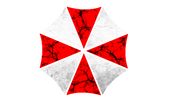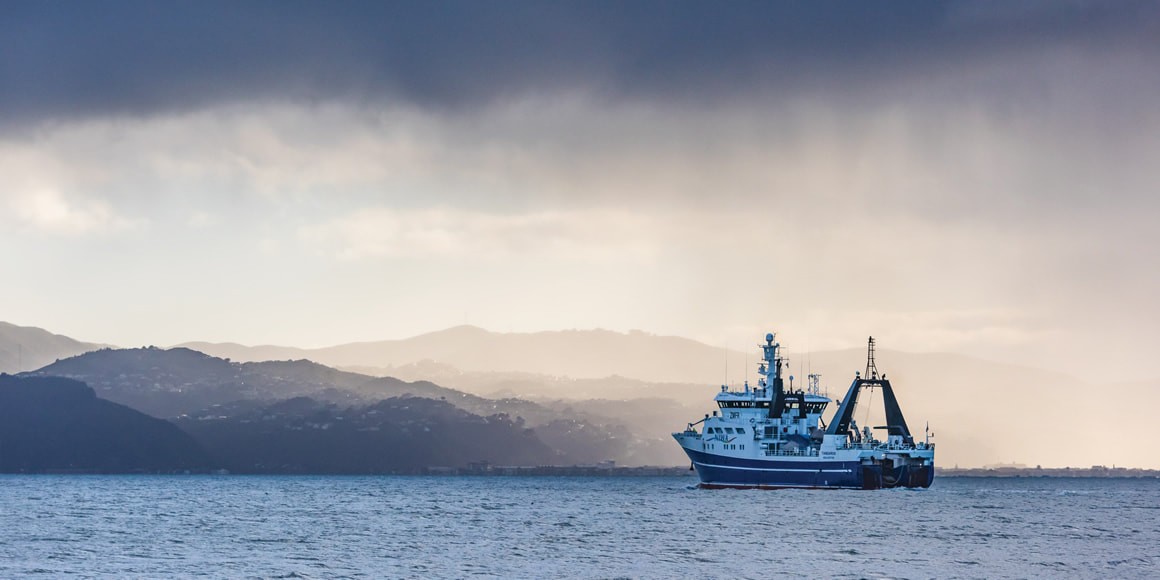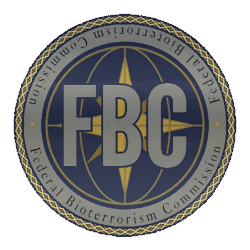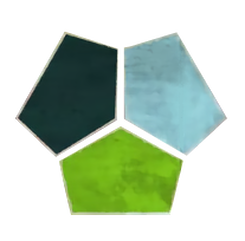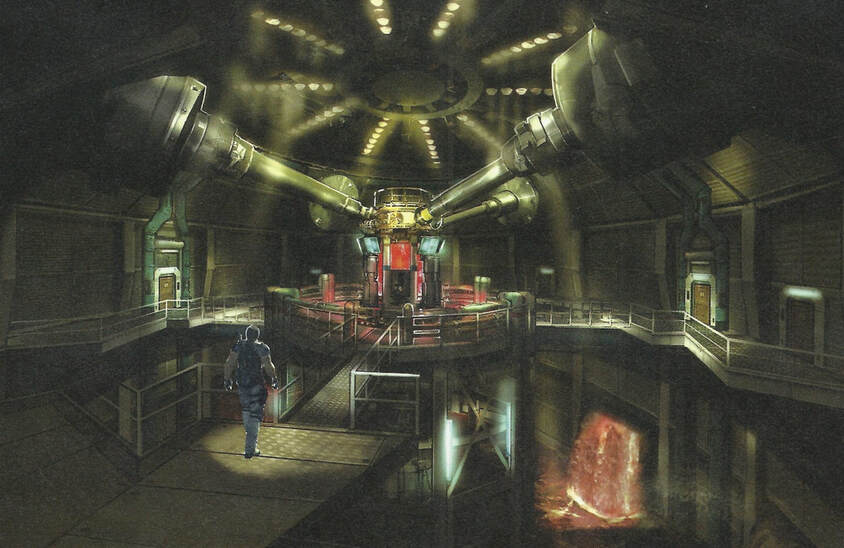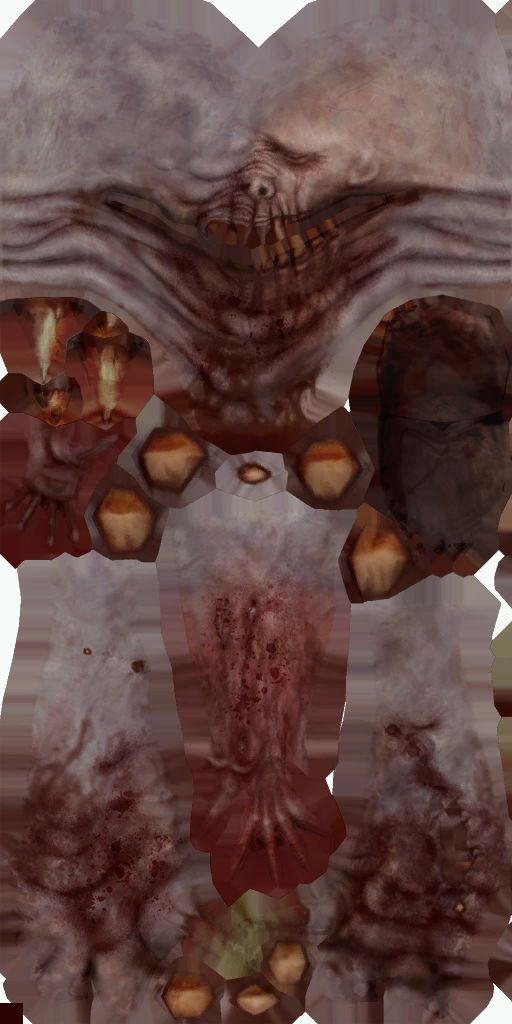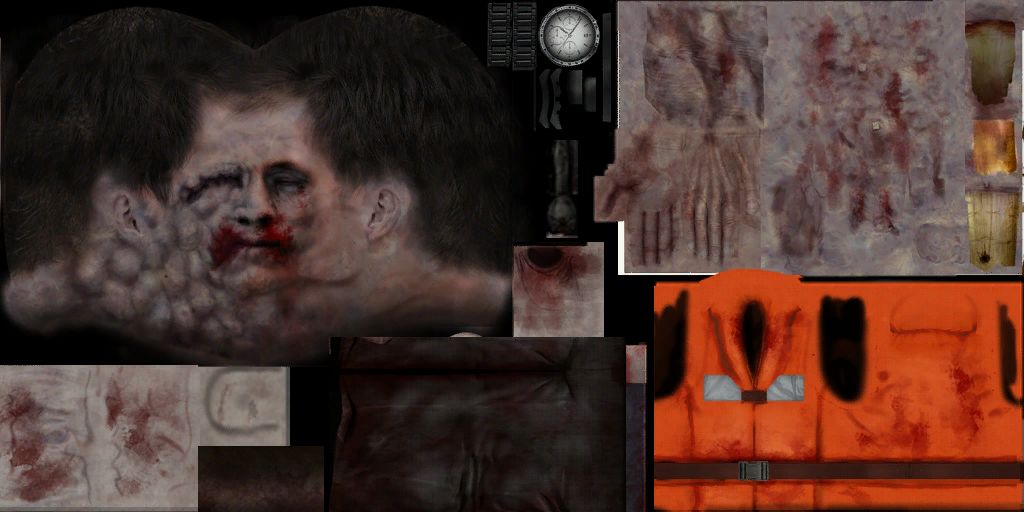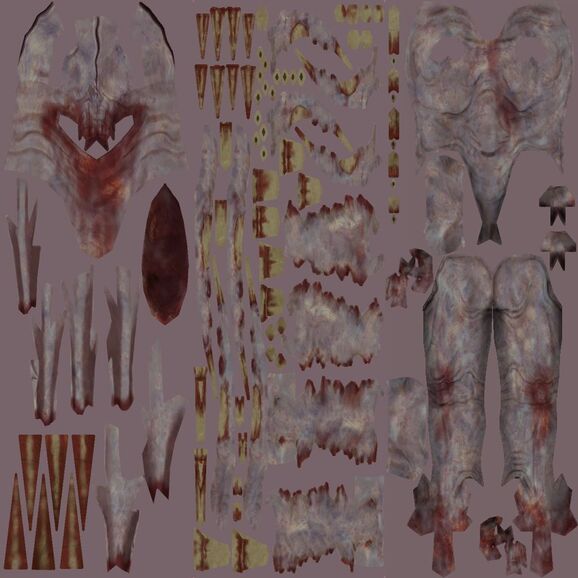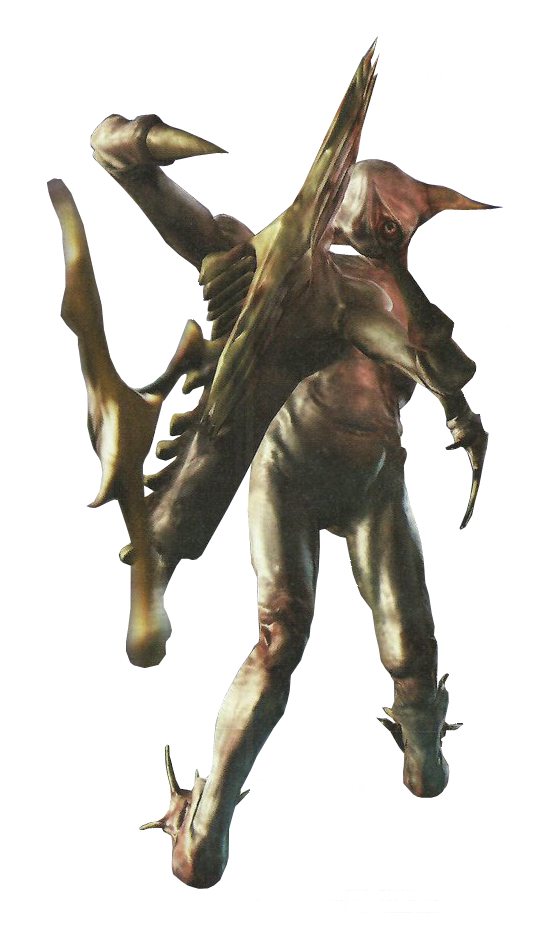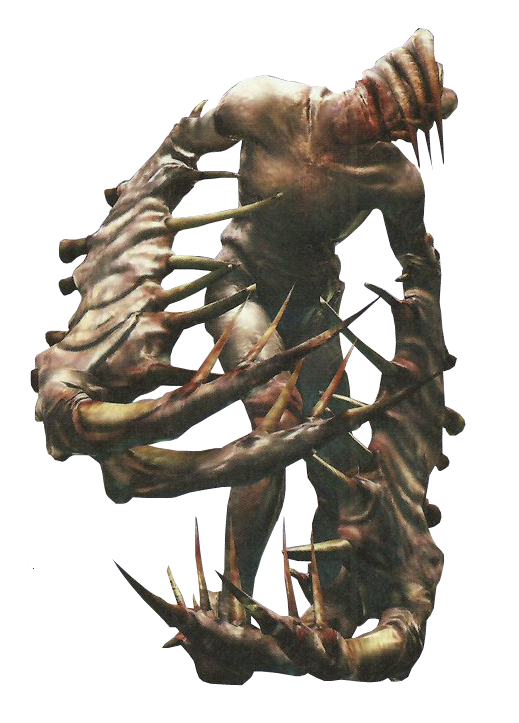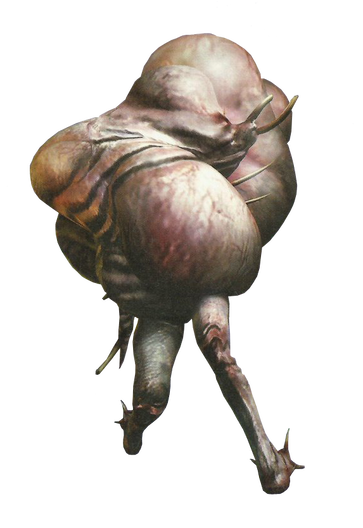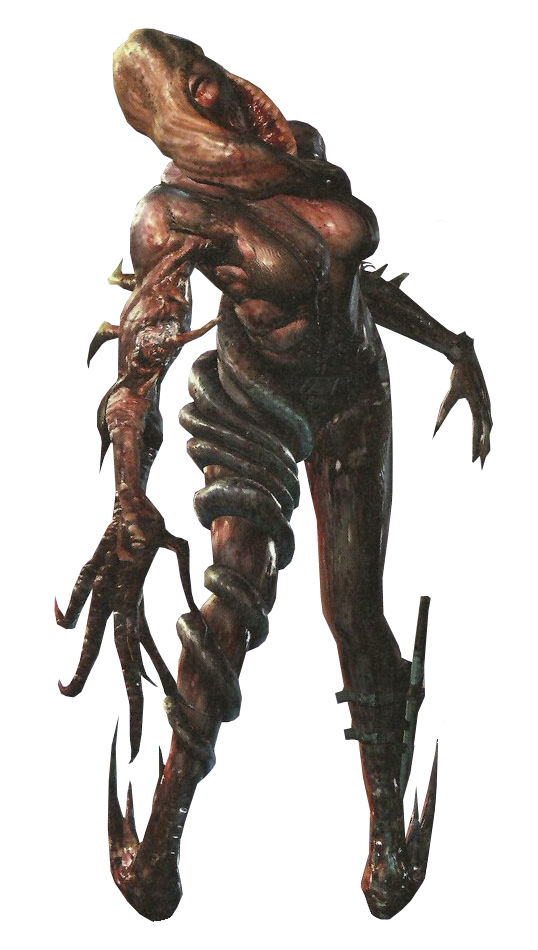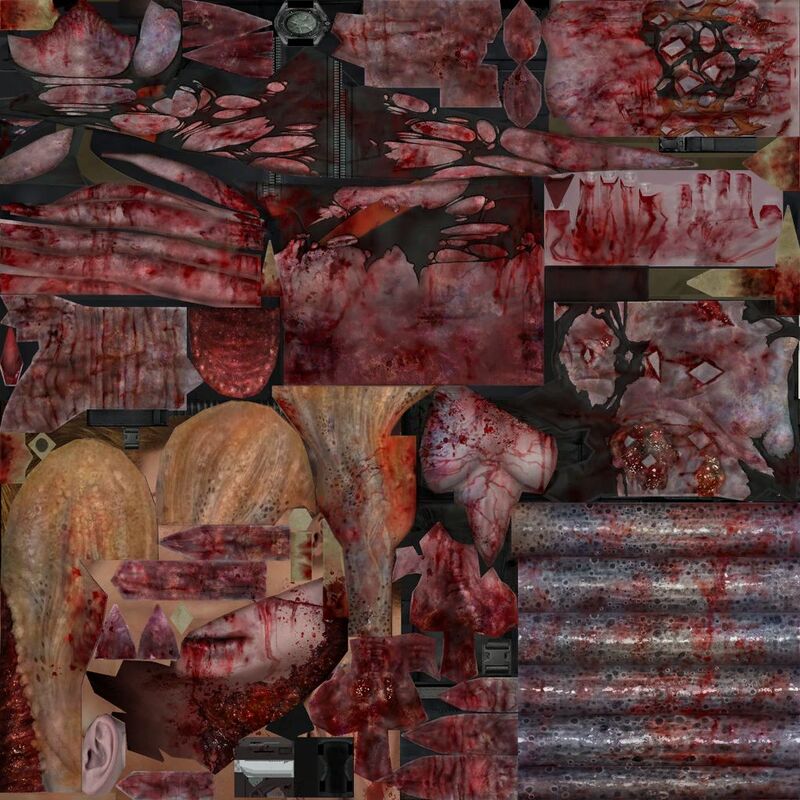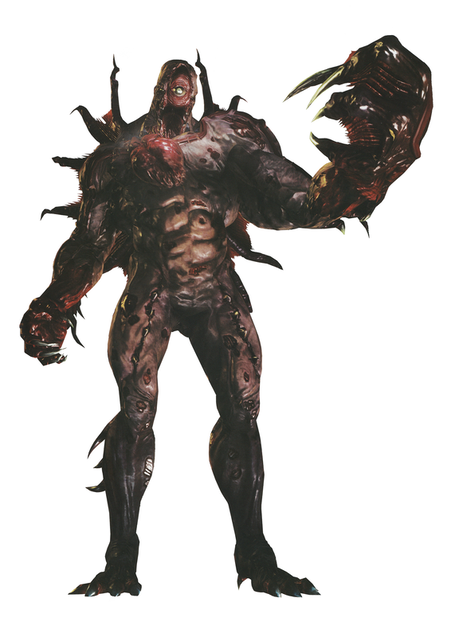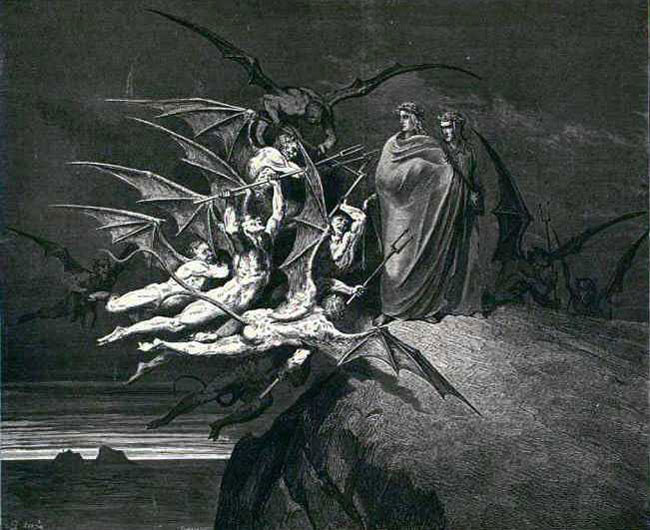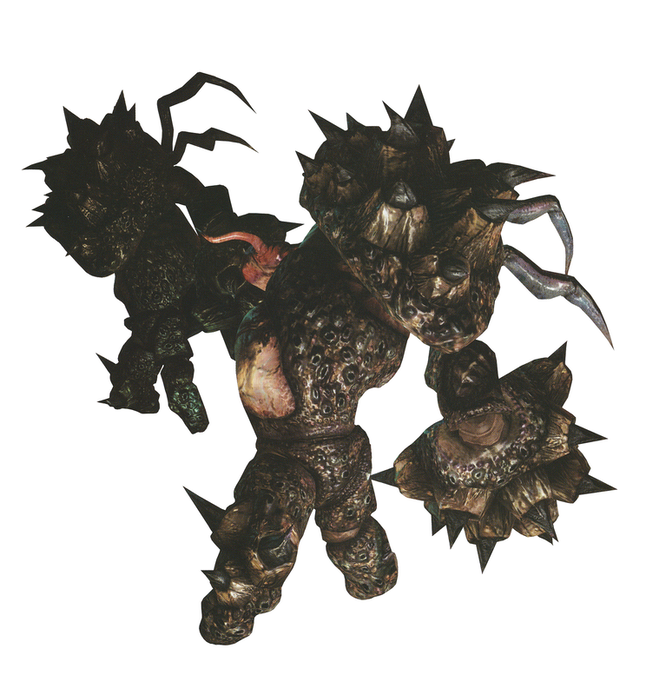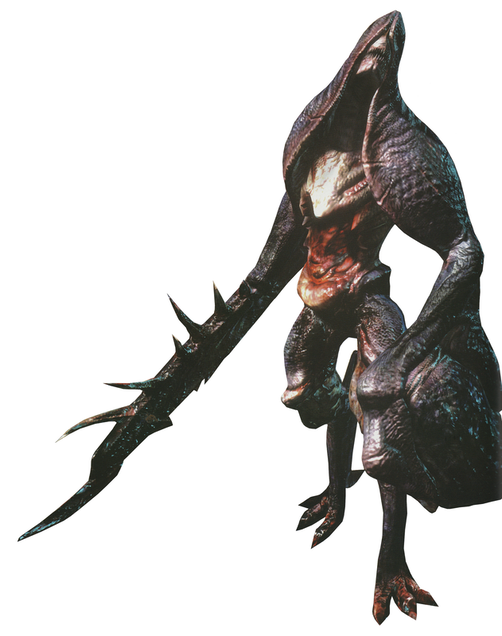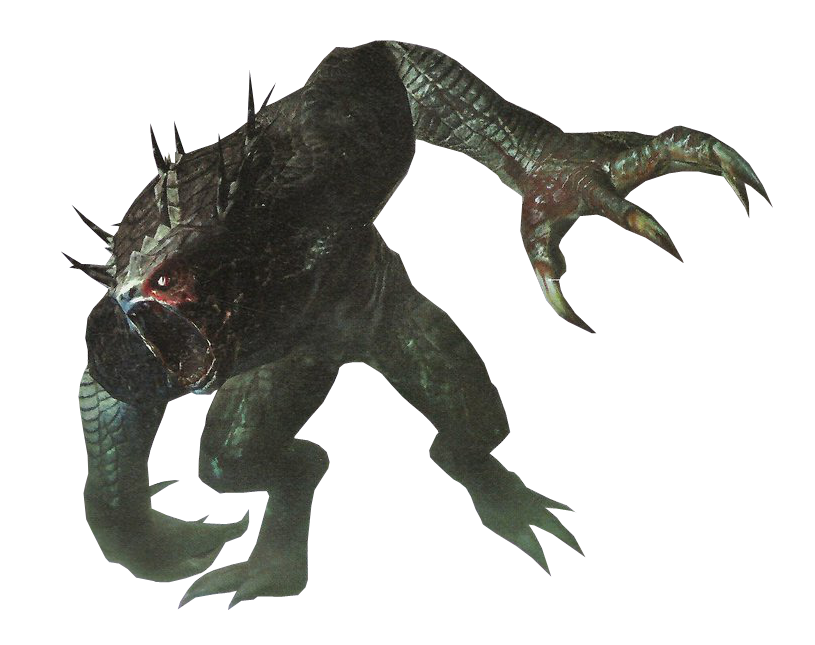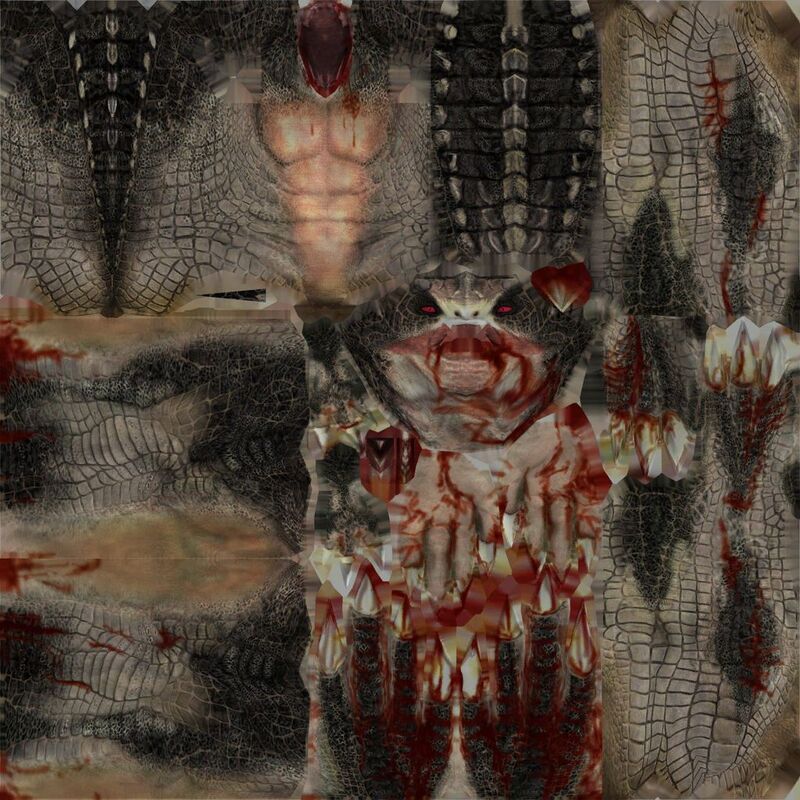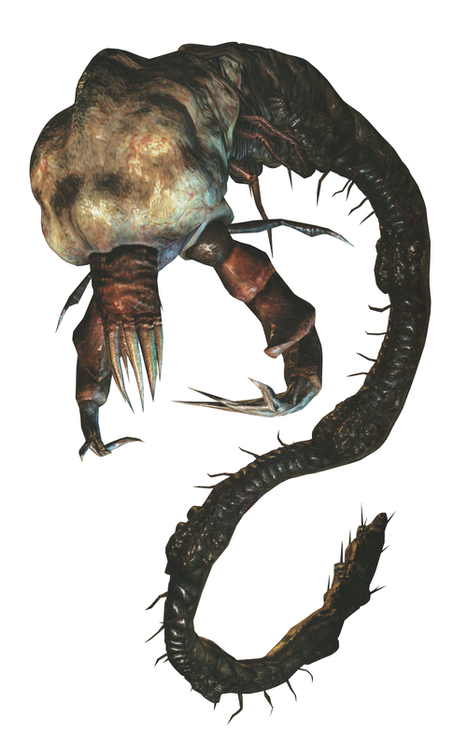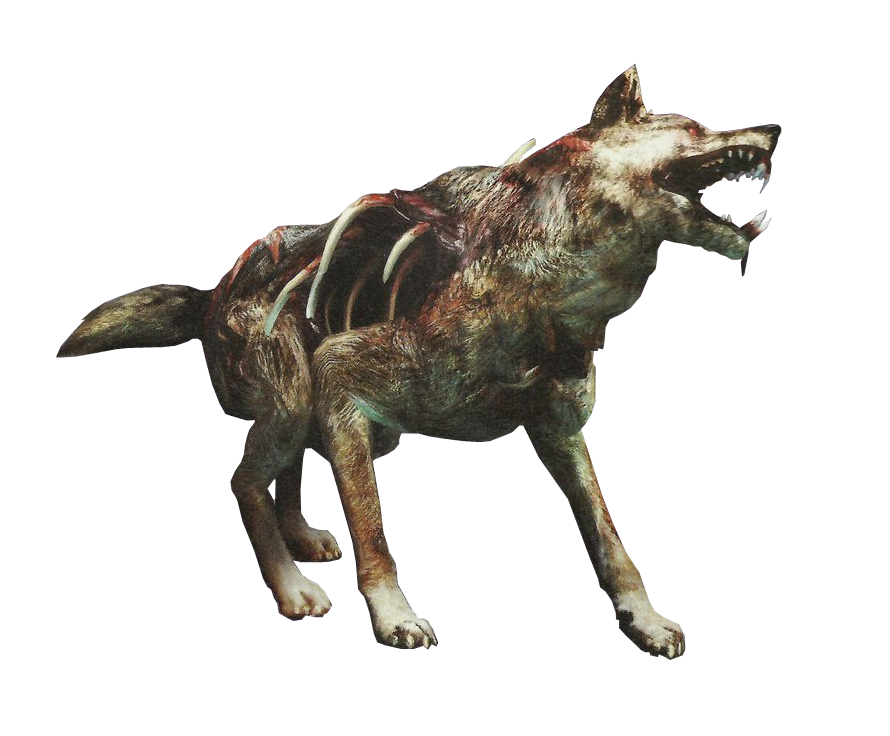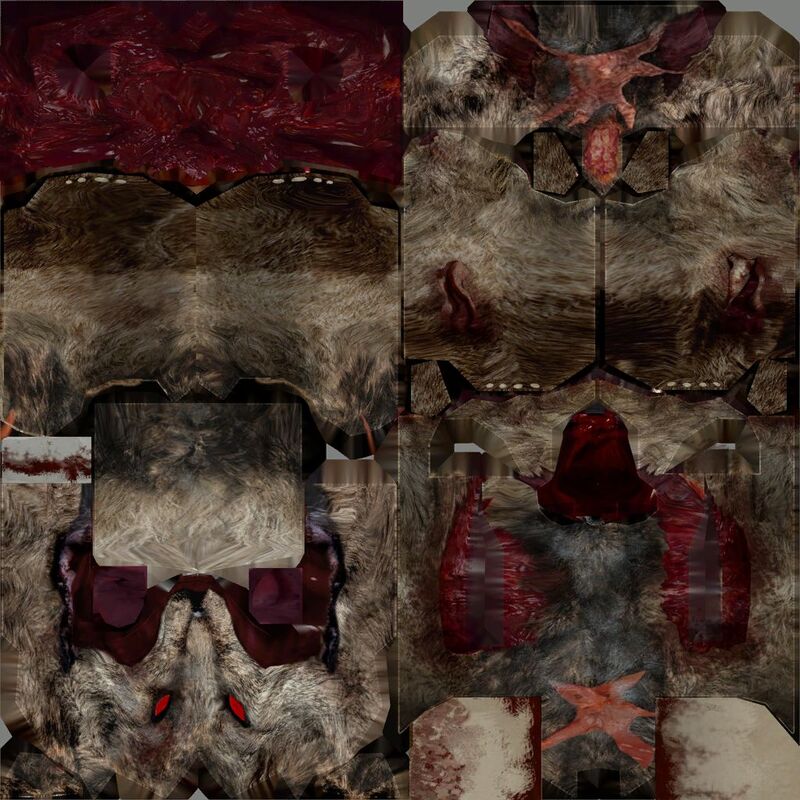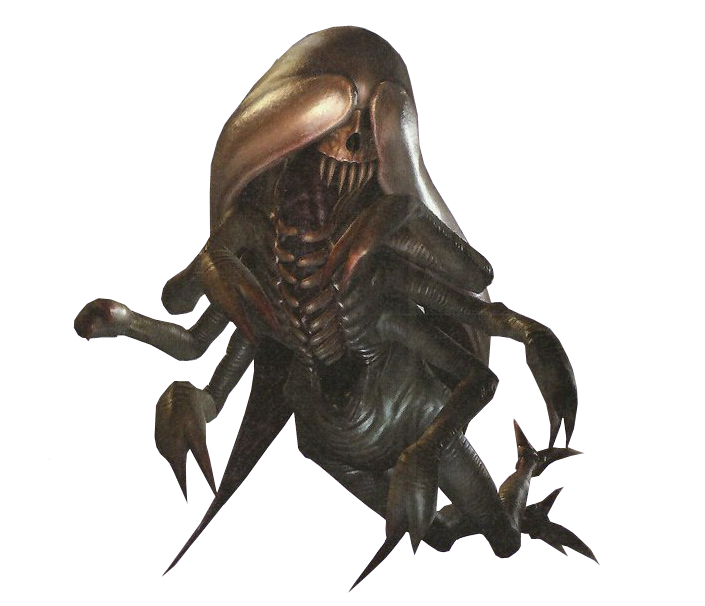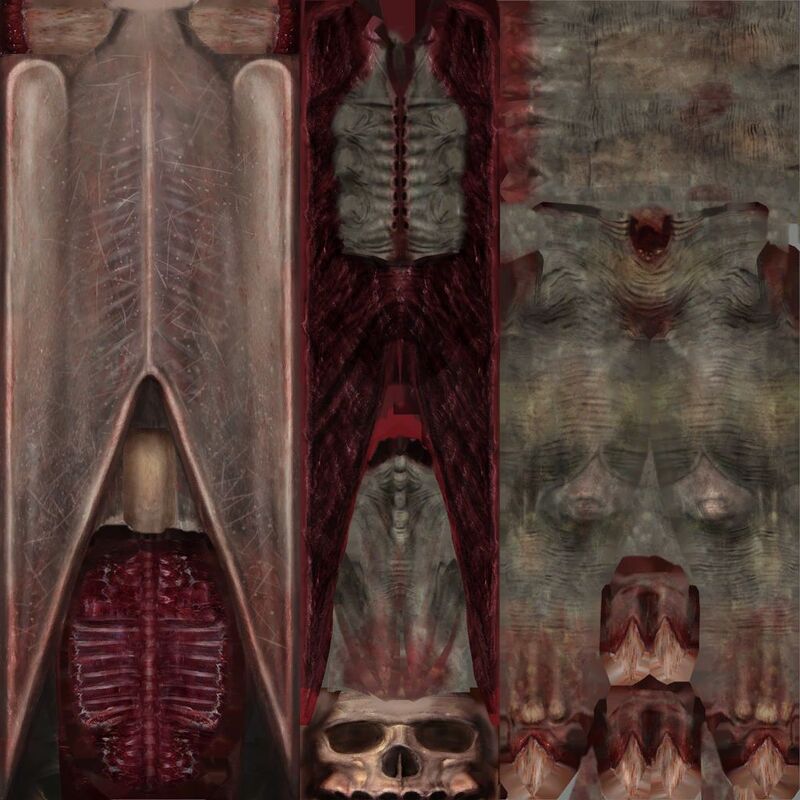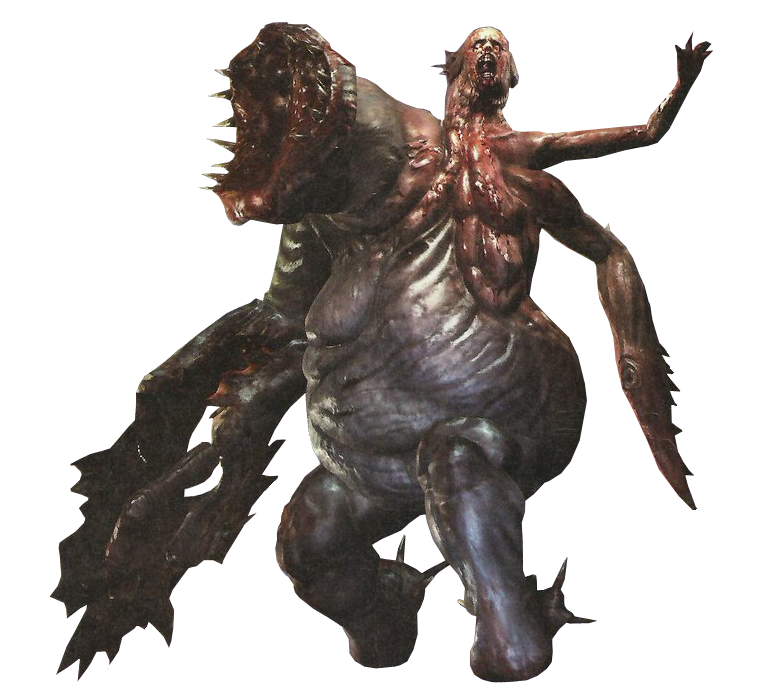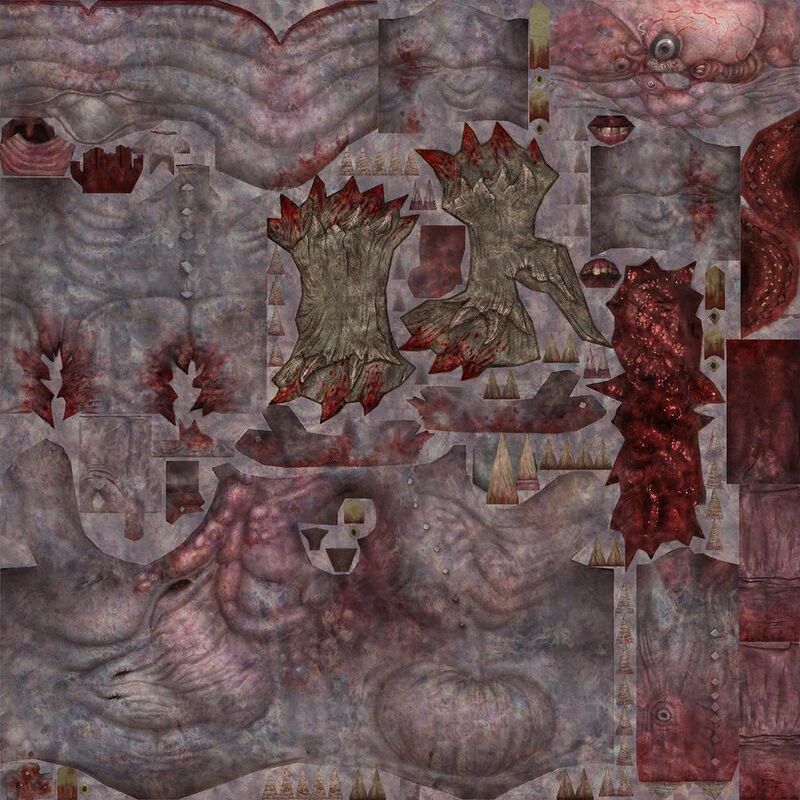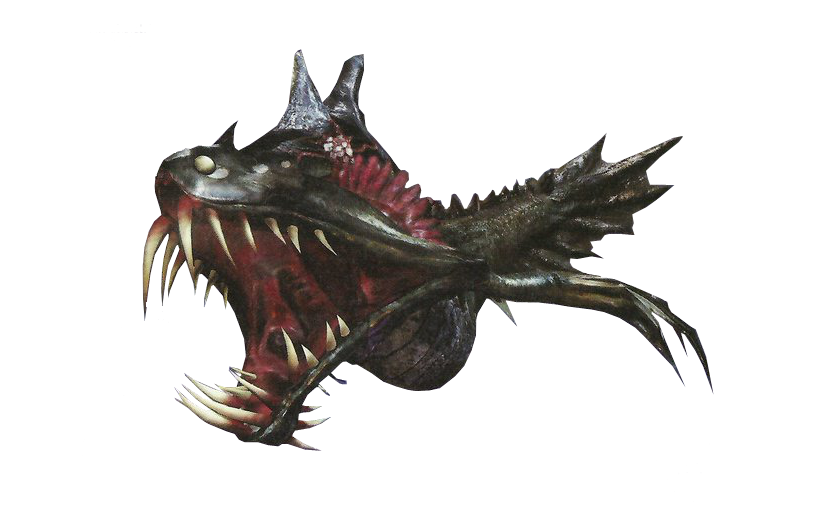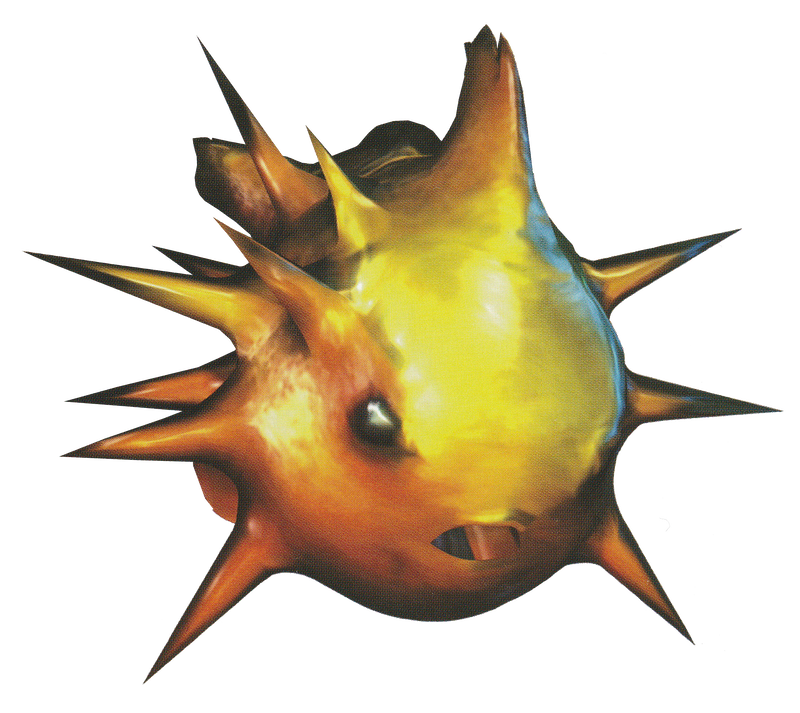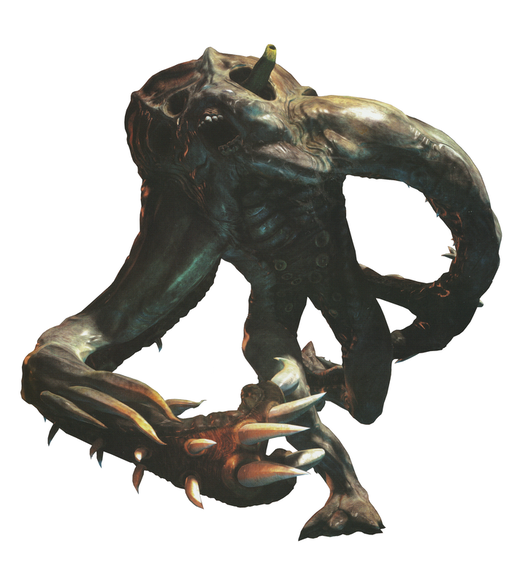The Tyrant-Abyss Virus is a marine bioweapon capable of creating powerful aquatic mutants. Developed under the University of Montpellier, TRICELL, and the FBC, it was responsible for the Terragrigia Panic. It is rarely used due to being a massive environmental risk under certain conditions like t-Veronica and Uroboros, but it paved the way for the development of efficient marine B.O.W.s.
Background
The Abyss Virus
During the fourth expedition to the Kermadec trench, the University of Montpellier discovered a new species of fish able to survive extreme depths due to mutations caused by a previously unknown virus. This virus, named the Abyss, was able to infect a vast variety of marine life, and could produce mutations in hosts reminiscent of traits seen in various kinds of fish.
Because of this, it is believed that like Progenitor and the Veronica Virus, the Abyss was involved in the development of life in the ocean. Since Progenitor can infect both insects and fish, however, and because its potential to create new animals is unlimited, it is safe to assume Progenitor's role was more universal. But since marine mutations caused by Progenitor are minimal, perhaps it, the Veronica, and the Abyss are actually all variants of the same virus, with each strain adapting to its respective environments/hosts.
This is further supported by the appearance of Abyss fish hosts – they (and Ghiozzo) take on traits similar to those seen on both Acanthodii and Placodermi, prehistoric fish. It is believed Acanthodii went extinct around 250 million years ago, while Placodermi went extinct around 358.9 million years ago. This indicates that the Abyss is not only very old, but that it influenced the development of ancient fish.
The Abyss converts the host's body fat and liquid into strong muscle and bone, creating a high-density frame capable of withstanding extreme pressure. It also causes host body fluids to be rapidly metabolized, and when transferred through blood there is a 99.76% probability of infection. In oral consumption of water containing the virus, the probability of infection is significantly lower (a detail which comes into play with the survivors of the Queen Dido, covered later). The Abyss' infection speed is greater than even the t-Virus.
This is further supported by the appearance of Abyss fish hosts – they (and Ghiozzo) take on traits similar to those seen on both Acanthodii and Placodermi, prehistoric fish. It is believed Acanthodii went extinct around 250 million years ago, while Placodermi went extinct around 358.9 million years ago. This indicates that the Abyss is not only very old, but that it influenced the development of ancient fish.
The Abyss converts the host's body fat and liquid into strong muscle and bone, creating a high-density frame capable of withstanding extreme pressure. It also causes host body fluids to be rapidly metabolized, and when transferred through blood there is a 99.76% probability of infection. In oral consumption of water containing the virus, the probability of infection is significantly lower (a detail which comes into play with the survivors of the Queen Dido, covered later). The Abyss' infection speed is greater than even the t-Virus.
Weaponization
|
While the Abyss could not infect land animals, its abilities in sea life exceeded the t-Virus, which had minimal success in marine B.O.W.s such as with Neptunes. FBC (Federal Bioterror Commission) director Morgan Lansdale and Excella Gionne (TRICELL corporation executive) collaborated in the development of a hybrid strain created from both viruses in order to create a weapon with enhanced capabilities. By splicing genes from the t-Virus into the Abyss, t-Abyss was created. Like T, t-Abyss was capable of infecting any organism, be it human, fish, etc., and at the same time retained the advantages of both viruses, resulting in a virus superior to T.
|
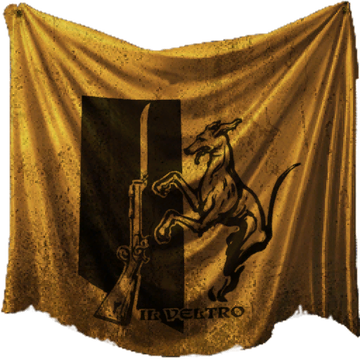
Lansdale betrayed Excella and kept the virus to himself. He orchestrated a massive outbreak that destroyed the floating city of Terragrigia by supplying t-Abyss and Hunter B.O.W.s to the organization Il Veltro ("The Greyhound", a Dante-inspired Italian student group turned radical nationalist terrorist organization). Lansdale did this in order to expand the influence of the FBC and to raise awareness of the danger posed by B.O.W.s. Lansdale afterwards betrayed Il Veltro and released the virus on their base of command: the sister cruise liner ships Queen Semiramis, Queen Zenobia, and Queen Dido. The Dido afterwards sunk to the bottom of the sea, while Lansdale used the other ships to study the spread of the virus and develop both new B.O.W.s and a vaccine for t-Abyss.
The BSAA eventually exposed Lansdale, leading to his arrest. But a sample of t-Abyss was recovered by triple-agents Raymond Vester and Jessica Sherewat, which was given to TRICELL for further bioweapons development.
The BSAA eventually exposed Lansdale, leading to his arrest. But a sample of t-Abyss was recovered by triple-agents Raymond Vester and Jessica Sherewat, which was given to TRICELL for further bioweapons development.
Effects
t-Abyss exceeds the t-Virus in infection speed and effectiveness in both land and sea hosts. Besides creating more practical fish B.O.W.s, it can also produce aquatic animal traits in human hosts, such as camouflage, bioelectrogenesis, and the ability to create illusions. Hosts of t-Abyss commonly develop the ability to breathe in both air and water (while some hosts such as Zombies do not breathe at all, they lack the energy needed to operate efficiently), greatly increasing their adaptability in combat. t-Abyss also makes hybridizations between land and sea animals much easier, and can even be used to enhance the abilities of other B.O.W.s.
While at least as virulent as the t-Virus on land, t-Abyss' spread speed is unimaginably fast in water. If a sufficient amount of the virus were released into the ocean, the entire sea would be affected as the virus starts a chain reaction of infection starting with microorganisms. This would result in an apocalyptic scenario very quickly. Water containing the virus turns red, like blood. This is possibly due to microorganisms becoming infected with the virus and developing pigments that effect the water. As noted by USSCommand, some beaches have pink sand due to single-cells organisms such as foraminifera.
While at least as virulent as the t-Virus on land, t-Abyss' spread speed is unimaginably fast in water. If a sufficient amount of the virus were released into the ocean, the entire sea would be affected as the virus starts a chain reaction of infection starting with microorganisms. This would result in an apocalyptic scenario very quickly. Water containing the virus turns red, like blood. This is possibly due to microorganisms becoming infected with the virus and developing pigments that effect the water. As noted by USSCommand, some beaches have pink sand due to single-cells organisms such as foraminifera.
Ooze
At first, the incredible infection speed and drastic mutations caused by t-Abyss resulted in the body's cells breaking down and in the death of the host, a problem shared with Progenitor. After modifications to the virus slowed its activity, total collapse was avoided, but cellular integrity was still compromised. Like T with Zombies, t-Abyss hosts are simultaneously weakened and strengthened, walking the line between life and death. Due to the relationship with liquid possessed by the Abyss, however, the "Zombies" created by t-Abyss, called Oozes, are significantly different.
As t-Abyss infects cells, the cell membrane begins to absorb excess water, causing it to swell due to osmotic pressure. The body's tissue begins to dissolve and fuse as a result, yet the host is kept active thanks to strengthened vitality.
As t-Abyss infects cells, the cell membrane begins to absorb excess water, causing it to swell due to osmotic pressure. The body's tissue begins to dissolve and fuse as a result, yet the host is kept active thanks to strengthened vitality.
Ooze bone and flesh has partially liquified, resulting in the deformation of the body. Facial features are wiped away along with sex organs, and they greatly resemble bloated, waterlogged corpses. While Oozes struggle to maintain a humanoid form because of this, due to the regenerative abilities from the t-Virus, Ooze tissue can partially re-solidify. This allows them to "pour" themselves through cracks and air vents to silently ambush prey and quickly navigate narrow spaces. While their bones are fragile, they can be mended in seconds. It's like fighting a puddle.
Despite lacking eyes, Oozes somehow possess the ability to “see” prey.
Despite lacking eyes, Oozes somehow possess the ability to “see” prey.
(Ooze, mid-transformation)
Due to the rapid overconsumption of body fluids due to the Abyss, Oozes are constantly dehydrated. This is not a problem for underwater creatures, but land-based hosts like Oozes must constantly replenish their fluids by drinking the blood and body fluids of others, rather than consuming flesh like Zombies. The tongues of Oozes have adapted to accomplish this, and in line with the fish qualities of t-Abyss, have transformed to resemble lamprey eels. They possess hundreds of sharp teeth in an opening at the end of the tongue, each capable of individual movement, and the tongue is so large that Oozes must disconnect the jaw to use it.
The liquified bones of Oozes seep out through the ends of the arms, then solidify on the outside, giving them sharp and blunt weapons. These usually result in Ooze hands becoming shapeless, bloody clubs, but two unique types exist.
Ooze Pincers have developed large, foldable claws with impressive reach, and have two intersecting, vertical rows of sharp teeth. Ooze Tricornes have distributed the mass from the left arm to the right, causing the left to become a nub and the right to swell into a form resembling an anchor or a crossbow. This "anchor" is primarily comprised of elongated fingers capable of launching bone projectiles over long distances, like the mutant forms of Hilda and Simmons, or like Strelacs. Tricornes have a single eye on the center of the head, used to target and single out prey. The name Tricorne comes from the fact their heads are shaped like 18th century hats.
Another effect of t-Abyss is the buildup of internal gases that cause the host to expand and explode. This was seen in a Globster in the second level of Revelations, but is more prominently seen in the Ooze Chunk, which act as suicide bombers. Chunks are created when an Ooze absorbs too much water, causing it to swell into a mass of useless flesh on legs. The lower body remains intact, while the swollen upper body has a fishbone-like spine running alongside it.
Most female hosts actually do not become Oozes, but there is at least one exception: Rachel Foley. She retained her intelligence and fine motor control, being able to speak, retreat, and run, and was able to regenerate extensively. Her right arm split open, and her mutated tongue emerged from a second mouth on the forehead. The development of extra arms and mouths seems to be a recurring symptom in t-Abyss hosts (Rachel, Scagdead, Sea Creeper), for reasons unknown. Her hair was either replaced by or turned into a fleshy growth, and eel-like growths wrapped around her limbs.
Rachel's mutation is stated to be a freak, random occurrence, although it is possible that other elements such as genetics, dosage, and environment were also a factor. In many ways Rachel could be seen as either the female equivalent of a Scagdead, or as a midway point between an Ooze and an Ultimate Abyss.
Ultimate Abyss
t-Abyss failed to produce the high-density frame of Abyss hosts in most humans due to cellular damage caused by the virus. But by carefully regulating infection in hosts, cellular breakdown could be avoided, the same concept used for creating Tyrants and super humans instead of Zombies. If infection could be controlled, hosts would become the Ultimate Abyss. This creature is the t-Abyss equivalent of a Tyrant, and inherits Tyrant features from the t-Virus. It's strengthened tissue, able to survive extreme depths, could resist gunfire, and intelligence would be unaffected, like with the other “Neo-Tyrants” Morpheus and Sergei.
The only known instance of an Ultimate Abyss was with the leader of Il Veltro, Jack Norman. In order to survive in the submerged Queen Dido for an entire year, the surviving members of Il Veltro infected themselves with small, diluted samples of t-Abyss, and fought off mutation via will (a concept explored in the t-Veronica analysis). Eventually, the members of Il Veltro degenerated, and their forms were farther removed from human than Oozes due to the prolonged infection.
These creatures, called Globsters ("grotesque blob monsters", a term used to describe unidentifiable corpses washed up on beaches), were giant pink lumps of flesh with large teeth on their undersides and almost no intelligence. They were difficult to kill due to their lumpy excess of body fat, and while their movement on land was limited, they were graceful swimmers. While most Globsters were former members of Il Veltro, it is possible regular Oozes eventually degenerate in a similar fashion.
Jack Norman, however, held off on mutation long enough to bond with t-Abyss and become an Ultimate Abyss. Besides his obvious Tyrant features and incredibly strong tissue, he also acquired several fish qualities, like a webbed claw. His face split open to reveal an eye similar to the one seen on Tricornes, which could emit a flash of light capable of creating illusions such as teleportation and multiplying himself. He had two exposed organs like those on other Tyrants: an exposed heart that could retract into his body like Hypnos, and a large orange growth on his back like the Tyrant 091. His back growth was flanked by protrusions that apparently functioned sort of like gills, able to extract oxygen from water.
Monster Norman was killed by Jill Valentine and Chris Redfield.
Monster Norman was killed by Jill Valentine and Chris Redfield.
Malebranche
Art by Gustave Dore. The painting is called the "Malbranche"
There are five known types of t-Abyss B.O.W.s, and four are named after members of the Malebranche (Italian for "evil claws"). The Malebranche are a group of twelve demons from The Divine Comedy, who guard a section of the eighth circle of the Inferno, in the Malebolge ("evil ditches"). Here they use grappling hooks to rip apart souls that try to escape the boiling pitch they are sentenced to be submerged in. In life, these souls were guilty of political fraud, like Morgan Lansdale.
Two of these four Dante-inspired B.O.W.s were created by inserting the genetic material of marine life into human embryos or ovums, like reptile DNA with the Hunter or fly with the Chimera. This is thanks to t-Abyss' increased abilities of genetic manipulation with fish.
Two of these four Dante-inspired B.O.W.s were created by inserting the genetic material of marine life into human embryos or ovums, like reptile DNA with the Hunter or fly with the Chimera. This is thanks to t-Abyss' increased abilities of genetic manipulation with fish.
Draghignazzo
The Draghignazzo (named after a demon in the Malebranche. Means "big nasty dragon" in Italian) was a massive human/tunicate (aka sea squirts) hybrid. While initially difficult to interpret its form, it is vaguely humanoid, but with a single arm. While its legs are small, by putting its massive arm in front of it, it can charge forward at surprising speeds. Its front is covered in an impenetrable shell formed by a calcium-based excretion, but it's back is fleshy and vulnerable. A mouth and eye can be seen extending from the back, with what resembles hair. It inherits a spine from its human base. A younger, faster version exists in RAID mode.
Draghignazzos are actually formed from a colony of individual zooids, like Sea Squirts, which reproduce asexually. A slain Draghignazzo will therefore fall apart into separate pieces.
The Draghignazzo (named after a demon in the Malebranche. Means "big nasty dragon" in Italian) was a massive human/tunicate (aka sea squirts) hybrid. While initially difficult to interpret its form, it is vaguely humanoid, but with a single arm. While its legs are small, by putting its massive arm in front of it, it can charge forward at surprising speeds. Its front is covered in an impenetrable shell formed by a calcium-based excretion, but it's back is fleshy and vulnerable. A mouth and eye can be seen extending from the back, with what resembles hair. It inherits a spine from its human base. A younger, faster version exists in RAID mode.
Draghignazzos are actually formed from a colony of individual zooids, like Sea Squirts, which reproduce asexually. A slain Draghignazzo will therefore fall apart into separate pieces.
Scarmiglione
Scarmiglione ("trouble maker") was another hybrid B.O.W. created using a human base and genes taken from multiple kinds of sharks. A great deal of information on Scarmigliones was related in a single document:
Scarmiglione ("trouble maker") was another hybrid B.O.W. created using a human base and genes taken from multiple kinds of sharks. A great deal of information on Scarmigliones was related in a single document:
"SCARMIGLIONE" DEVELOPMENT DOCUMENT
The Scarmiglione is a B.O.W. utilizing shark DNA, considered a promising prospect from the beginning of development. Sharks have been perfected as predators of the seas for hundreds of millions of years, so there has been no change in their morphology. By incorporating that DNA, ferocity and aggressiveness as a weapon are equally promising.
While Scarmiglione's shape is deeply ingrained with the form of its shark ancestors, protrusions shaped like spears are present on its limbs.
These spiny shapes are peculiar to cartilaginous fish. Parts of its placoid scales transformed and connected to strong muscle fibers. These allow it to stab and make it capable of alert and agile movements just like land animals.
The changes in its placoid scales don't stop there. It has front armor nearing an armored car in strength, incomparable with that of a shark. It successfully gained a high rate of defense that could be said to have made it invincible against frontal attacks.
The invincible "shield" on the left arm of a Scarmiglione has a gigantic thumb or finger that connects to the rest of the shield that can disconnect, presumably to grip prey or objects.
The "spear" on the right arm is made of a sawshark snout and lined with shark teeth. It is strong enough to tear through steel with ease.
While Scarmiglione scales are especially concentrated in the ends of the arms, they lack any covering for the belly region. The ribcage and intestines are visible and exposed here, which is a clear fault in development. The Scarmiglione’s gills are located in the gaps of the chest.
Scarmiglione movements are slow, steady, and rigid. This is perhaps due to their hardened scales. But they have impressive jumping abilities thanks to their strong muscles.
Besides inheriting the shape and placoid scales of sharks, Scarmigliones also possess Ampullae of Lorenzini - organs in sharks that allow them to sense electrical and magnetic fields. Scarmigliones use these to detect the electrical signal produced by the motion of prey. As they have no discernable eyes, they may use these ampullae in place of the sense of sight.
A Scarmiglione curiously can adapt in response to damage. If its upper body is damaged, it's spine will break free and use the legs to continue to attack targets. This spine can discharge harmful electricity, like an electric eel. Eyeballs can be seen attached to this spine, which substitute the destruction of the ampullae. These eyes may mean the shark-like head grew around the eyeballs, without sockets for them to be of use in its intact form.
If its lower body is damaged instead, it will crawl with its arms, and the jaw extends outside the head like a goblin shark.
These B.O.W.s, while less powerful individually than the adult Draghignazzo, were more efficient as weapons, and were cloned and stored in the Queen Zenobia's laboratory. Whether or not they made it to the black market is unknown.
The "spear" on the right arm is made of a sawshark snout and lined with shark teeth. It is strong enough to tear through steel with ease.
While Scarmiglione scales are especially concentrated in the ends of the arms, they lack any covering for the belly region. The ribcage and intestines are visible and exposed here, which is a clear fault in development. The Scarmiglione’s gills are located in the gaps of the chest.
Scarmiglione movements are slow, steady, and rigid. This is perhaps due to their hardened scales. But they have impressive jumping abilities thanks to their strong muscles.
Besides inheriting the shape and placoid scales of sharks, Scarmigliones also possess Ampullae of Lorenzini - organs in sharks that allow them to sense electrical and magnetic fields. Scarmigliones use these to detect the electrical signal produced by the motion of prey. As they have no discernable eyes, they may use these ampullae in place of the sense of sight.
A Scarmiglione curiously can adapt in response to damage. If its upper body is damaged, it's spine will break free and use the legs to continue to attack targets. This spine can discharge harmful electricity, like an electric eel. Eyeballs can be seen attached to this spine, which substitute the destruction of the ampullae. These eyes may mean the shark-like head grew around the eyeballs, without sockets for them to be of use in its intact form.
If its lower body is damaged instead, it will crawl with its arms, and the jaw extends outside the head like a goblin shark.
These B.O.W.s, while less powerful individually than the adult Draghignazzo, were more efficient as weapons, and were cloned and stored in the Queen Zenobia's laboratory. Whether or not they made it to the black market is unknown.
Farfarello
Another t-Abyss B.O.W. exists called the Farfarello ("goblin"). These are mass production type Hunters which were injected with t-Abyss to enhance their abilities. Besides having fish-like physical qualities, these Hunters gained the ability to camouflage themselves like some species of fish, to such a degree they appear to be invisible. Their eyes became blood red, probably due to burst blood vessels, a common symptom of Progenitor-related viruses.
Two almost universal effects are common to viruses related to the Progenitor Virus - an increase in both height and aggression. Since Farfarellos contain two viruses, these effects have "stacked", so to speak. As a result, they are larger and more aggressive than regular Hunters. So much so it is difficult to train and control them, harming their commercial viability.
Malacoda
The final B.O.W. named after the Malebranche is the Malacoda ("evil tail", the leader of the Malebranche). It is a skin fluke parasite that became infected with the virus by accident during t-Abyss administration to its host. These worm-like creatures secreted t-Abyss-infected liquids that could infect and mutate the parasite's host. The infected host and parasite then develop a unique symbiote and operate and fight in unison.
The Malacoda was studied after discovery for use as a B.O.W. which could infect and augment other organisms. While only 1cm in length as larvae, the Malacoda's growth could increase after parasitizing an animal, in direct proportion to its host. This means the Malacoda could grow by infecting larger animals.
After some escaped from the Queen Zenobia, they found a home inside a whale. The Malacodas grew gigantic as a result, and bred in its body uncontrollably. While some left the whale to hunt in the sea alone, others used the whale as a hive. The whale itself mutated extensively from t-Abyss. It developed sharp teeth and finger/claw-like appendages from its tail that it used to latch onto the Queen Zenobia's deck. From its blowhole sprayed red liquid containing the virus which, according to the artbook, becomes a red mist containing an airborne strain of t-Abyss.
The Malacodas and the whale operated in tandem, with the parasites acting as its “arms”. The head of the parasites were modeled by the game developers after bed bugs.
The final B.O.W. named after the Malebranche is the Malacoda ("evil tail", the leader of the Malebranche). It is a skin fluke parasite that became infected with the virus by accident during t-Abyss administration to its host. These worm-like creatures secreted t-Abyss-infected liquids that could infect and mutate the parasite's host. The infected host and parasite then develop a unique symbiote and operate and fight in unison.
The Malacoda was studied after discovery for use as a B.O.W. which could infect and augment other organisms. While only 1cm in length as larvae, the Malacoda's growth could increase after parasitizing an animal, in direct proportion to its host. This means the Malacoda could grow by infecting larger animals.
After some escaped from the Queen Zenobia, they found a home inside a whale. The Malacodas grew gigantic as a result, and bred in its body uncontrollably. While some left the whale to hunt in the sea alone, others used the whale as a hive. The whale itself mutated extensively from t-Abyss. It developed sharp teeth and finger/claw-like appendages from its tail that it used to latch onto the Queen Zenobia's deck. From its blowhole sprayed red liquid containing the virus which, according to the artbook, becomes a red mist containing an airborne strain of t-Abyss.
The Malacodas and the whale operated in tandem, with the parasites acting as its “arms”. The head of the parasites were modeled by the game developers after bed bugs.
Other Monsters
Fenrir
The only t-Abyss B.O.W. not named after the Malebranche is the Fenrir, which is instead named after a giant Scandinavian cryptic. The Fenrir are Eurasian wolves injected with t-Abyss, and their abilities are similar to the Cerberus B.O.W.. Fenrir have red eyes (like the Farfarello) and a gaping hole in the chest, likely due to necrosis.
The designer at CAPCOM was inspired by a fairy tale he heard as a child where a wolf survived its stomach being ripped open (maybe The Wolf and the Kids or Little Red Riding Hood) to create this B.O.W.. Originally, it was to open its stomach with a newly developed mouth on the body and drop its digestive organs on pinned prey to digest them directly. But they had trouble animating this, so the final design just features a large hole.
Some Fenrirs with dark fur have grown in size. The smaller Fenrir with grey fur, retaining pack instincts, treat the larger Fenrir as pack leaders.
Fenrir packs circle and take turns attacking prey to confuse, intimidate, and exhaust them, as they slowly torture prey to death. They can howl for help from the rest of the pack as well.
The only t-Abyss B.O.W. not named after the Malebranche is the Fenrir, which is instead named after a giant Scandinavian cryptic. The Fenrir are Eurasian wolves injected with t-Abyss, and their abilities are similar to the Cerberus B.O.W.. Fenrir have red eyes (like the Farfarello) and a gaping hole in the chest, likely due to necrosis.
The designer at CAPCOM was inspired by a fairy tale he heard as a child where a wolf survived its stomach being ripped open (maybe The Wolf and the Kids or Little Red Riding Hood) to create this B.O.W.. Originally, it was to open its stomach with a newly developed mouth on the body and drop its digestive organs on pinned prey to digest them directly. But they had trouble animating this, so the final design just features a large hole.
Some Fenrirs with dark fur have grown in size. The smaller Fenrir with grey fur, retaining pack instincts, treat the larger Fenrir as pack leaders.
Fenrir packs circle and take turns attacking prey to confuse, intimidate, and exhaust them, as they slowly torture prey to death. They can howl for help from the rest of the pack as well.
All other known t-Abyss mutants are irregular mutants, arguably.
Sea Creeper
Most female humans do not actually become Oozes, but Sea Creepers instead. It is unknown exactly why this is, but Jessica claims it is related to chromosomes (depending on how you interpret her line in her report). Sea Creepers have mutated into aquatic animals with limited/no land-based movements. They have developed six arms for swimming and grabbing prey, and it is said to be impossible to escape their grasp due to "it reminding them of their mother's embrace", oddly enough. Sea Creepers will drag prey under the water and drown them. After this they will proceed to eat them.
A protective growth runs along the back, resembling hair. This growth is a carapace which reduces friction in water, making them swift and silent swimmers. This growth resembles the “hair growth” of Mutant Rachel. Part of the mutated skull remains, and a second mouth has developed along the front of the body. While they are stealthy swimmers, hence the name, they let out a characteristic chiming sound.
A protective growth runs along the back, resembling hair. This growth is a carapace which reduces friction in water, making them swift and silent swimmers. This growth resembles the “hair growth” of Mutant Rachel. Part of the mutated skull remains, and a second mouth has developed along the front of the body. While they are stealthy swimmers, hence the name, they let out a characteristic chiming sound.
Scagdead
One in approximately one thousand humans are resistant to t-Abyss. However, they are not immune, and virus activity slowly continues in the body. Rather than adapting like the Ultimate Abyss or degenerating completely like the Globster, they are slowly transformed into the Scagdead mutant.
As transformation progresses, the host is left awake and aware. The body develops a second head in the place of an Ooze tongue, which acts as a separate organism that will begin to gradually wrestle control of the body away from the host. Eventually, the host head and left arm are the only remaining sections not transformed into the Scagdead. The rest of the body transforms into fatty Ooze flesh, so thick as to turn them into bullet sponges, but the original head remains a weak point. A new left arm has developed, and the right arm has developed an organic contraption similar to a buzz saw, capable of movement as if motorized. The new head has a vertical mouth with sharp teeth suitable for grabbing prey, and it is capable of launching its detachable jaws (which are immediately replaced) onto the ground, which act like bear traps. Due to its large size, a Scagdead develops a large appetite for flesh, unlike the typical Ooze which is driven to consume fluids instead.
The original head, as seen with the Queen Zenobia's Communications Officer, will randomly shout out simple phrases, but the brain at this point has been so degraded that it is nothing more than spasms from a dead brain still clutching onto small memories. Eventually the original head is fully mutated as well, and loses any remaining human features.
“Scag” refers to a tear in fabric or clothing. “Scagdead” means “Torn Dead", in reference to both the creatures’ torn flesh, and its torn mind.
As transformation progresses, the host is left awake and aware. The body develops a second head in the place of an Ooze tongue, which acts as a separate organism that will begin to gradually wrestle control of the body away from the host. Eventually, the host head and left arm are the only remaining sections not transformed into the Scagdead. The rest of the body transforms into fatty Ooze flesh, so thick as to turn them into bullet sponges, but the original head remains a weak point. A new left arm has developed, and the right arm has developed an organic contraption similar to a buzz saw, capable of movement as if motorized. The new head has a vertical mouth with sharp teeth suitable for grabbing prey, and it is capable of launching its detachable jaws (which are immediately replaced) onto the ground, which act like bear traps. Due to its large size, a Scagdead develops a large appetite for flesh, unlike the typical Ooze which is driven to consume fluids instead.
The original head, as seen with the Queen Zenobia's Communications Officer, will randomly shout out simple phrases, but the brain at this point has been so degraded that it is nothing more than spasms from a dead brain still clutching onto small memories. Eventually the original head is fully mutated as well, and loses any remaining human features.
“Scag” refers to a tear in fabric or clothing. “Scagdead” means “Torn Dead", in reference to both the creatures’ torn flesh, and its torn mind.
Ghiozzo and Aculeozzo
Ghiozzos (Italian for goby) are small fish infected with t-Abyss. They grow in size and mutate to resemble the original fish infected with the Abyss in the Kermadec Trench. They have black scales and razor-sharp teeth, despite originally being completely harmless. Their vitality and ferociousness are so great that they actually will leap out of water to pursue prey, able to survive on land for some time. They are able to propel themselves forward on land by leaping short distances using their elongated, arm-like fins. Compare this to Neptunes or t-Virus-infected piranhas, which, while able to survive without water for some time and in captivity, could not continue pursuit on land.
While able to withstand some gunfire, Ghiozzos are relatively weak when compared to other creatures created from t-Abyss infection. However, they have the intelligence to cooperate and swarm their prey in groups.
In concept art, Ghiozzos are depicted as having worm-like parasites devouring their flesh. These parasites are described as being very aggressive, and may actually be Malacoda parasites (albeit smaller due to parasitizing a small host).
While able to withstand some gunfire, Ghiozzos are relatively weak when compared to other creatures created from t-Abyss infection. However, they have the intelligence to cooperate and swarm their prey in groups.
In concept art, Ghiozzos are depicted as having worm-like parasites devouring their flesh. These parasites are described as being very aggressive, and may actually be Malacoda parasites (albeit smaller due to parasitizing a small host).
Aculeozzos are a variant of the Ghiozzo created from lumpfish. They lack sharp fangs, but are inflated and covered in sharp points like those on blowfish. They too can operate on land, and hurl themselves at targets with greater agility than Ghiozzos. If gameplay is any indication, they aren't very menacing. Aculeo is Italian for stinger or spine. Ozzo means “dear little”.
Wall Blister
Wall Blisters are created from t-Abyss-infected barnacles. The barnacle life in the Queen Zenobia's pool area grew exponentially due to the virus, but some exhibited unique mutations and spread throughout the ship. They would grow on various surfaces into large clumps, then detach themselves in the presence of prey and become mobile. They had developed traits from both humans and red-ringed octopi, including tentacles used as arms and legs and a humanoid form and mouth. They also developed the light-emitting organ of vampire squids. Despite being relatively weak they were very fast and strong. Their long, elastic "arms" tipped with claws could easily lift an adult human and snap their spine.
It is unknown why barnacles developed traits from other animals exactly, but it's highly likely the human traits came from the T percentage of t-Abyss, while the octopus and squid traits came from the Abyss percentage. It is also unknown if Wall Blisters were escaped B.O.W.s that took up residence in the pool, or if they were irregular mutants created by a viral leak.
It is unknown why barnacles developed traits from other animals exactly, but it's highly likely the human traits came from the T percentage of t-Abyss, while the octopus and squid traits came from the Abyss percentage. It is also unknown if Wall Blisters were escaped B.O.W.s that took up residence in the pool, or if they were irregular mutants created by a viral leak.
